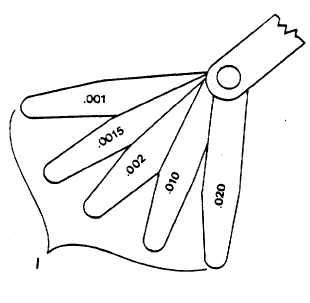|
| |
TM 9-254
4-2.
Use of Gages - Continued
Look at the space to be measured (1) and estimate the thickness needed to fill the space, (approximately
.035 inch).
CAUTION
Do not force blades into space at any time. Forcing blades may damage the gage or the surfaces
of the material being measured.
Choose several thick blades to fill the space, (for instance .020 + .010 + .005). Turn the blades so they are
all stacked together and try to insert the blades (2) into the space to be measured (1). If stacked blades are
too thick to fit into space to be measured (1) remove gage.
Fold back a thick blade and insert thinner blades in place of the thick blade. Continue to measure the space
between the two surfaces until a snug fit is obtained.
If the blades of the thickness gage (2) do not fill the space being measured, add blades or substitute thicker
blades until you have a snug fit.
Remove the blades of the thickness gage and read the thickness of each, add the numbers together.
In this example (fig. 4-16), the thickness of each blade used to measure the space is: .020 + .010 + .002 +
.0015 + .001 = .0345. Rounded off to .035 inch.
Figure 4-16. Thickness Gage
4-13
|

